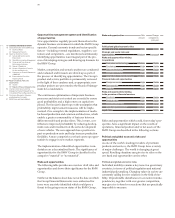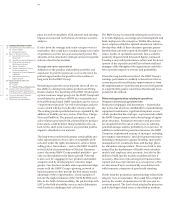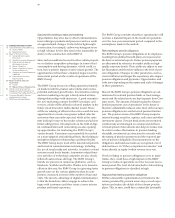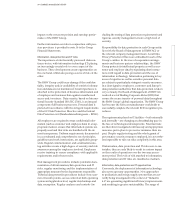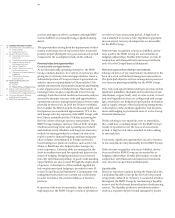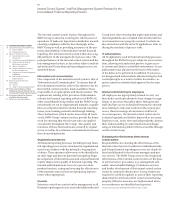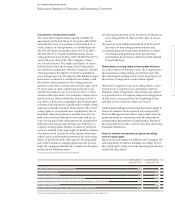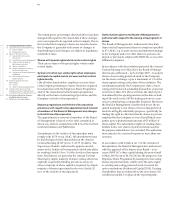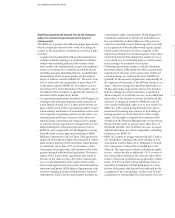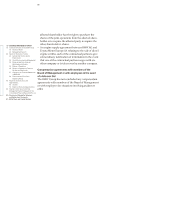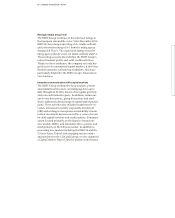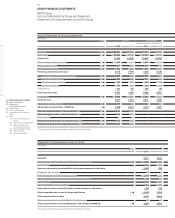BMW 2014 Annual Report Download - page 80
Download and view the complete annual report
Please find page 80 of the 2014 BMW annual report below. You can navigate through the pages in the report by either clicking on the pages listed below, or by using the keyword search tool below to find specific information within the annual report.
80
18 COMBINED MANAGEMENT REPORT
18
General Information on the
BMW
Group
18 Business Model
20 Management System
23 Report on Economic Position
23 General and Sector-specific
Environment
26 Overall Assessment by Management
26
Financial and Non-financial
Performance Indicators
29 Review of Operations
49 Results of Operations, Financial
Position and Net Assets
61 Comments on Financial Statements
of BMW AG
64 Events after the End of the
Reporting Period
65 Report on Outlook, Risks and
Opportunities
65 Outlook
70 Report on Risks and Opportunities
82 Internal Control System and Risk
Management System Relevant for
the
Consolidated Financial Reporting Process
83 Disclosures Relevant for Takeovers
and Explanatory Comments
87
BMW Stock and Capital Markets
A residual value risk exists if the expected market value
of the vehicle at the end of the contractual term is lower
than its residual value at the date the contract is entered
into. Each vehicle’s market value is forecast on the basis
of historical external and internal data and used to pre-
dict the expected market value of the vehicle at the end
of the contractual period. As part of the process of
managing residual value risks, a calculation is performed
at the inception of each contract to determine the pre-
sent
value of risk costs. Market developments are ob-
served throughout the contractual period and the risk
assessment updated appropriately.
If residual value risks were to materialise, they could have
a high impact on Group earnings over the
two-year
assessment period. The impact on the segments affected
would be on a medium scale. The level of risk is classi-
fied as high for the Group as a whole. The BMW Group
classifies potential residual value opportunities as
material.
Interest rate risks and opportunities
Interest rate risks in the Financial Services segment relate
to potential losses caused by changes in market interest
rates and can arise when fixed interest rate periods for
assets and liabilities recognised in the balance sheet do
not match. Interest rate risks in the Financial Services
line of business are managed by raising refinancing funds
with matching maturities and by employing interest rate
derivatives.
If interest rate risks were to materialise, they are only
likely to result in a low impact on the BMW Group’s
results of operations over the two-year assessment
period. The level of risk attached to interest rate risks
is
classified as medium.
The BMW Group classifies potential interest rate oppor-
tunities as material.
Liquidity and operational risks
Use of the “matched funding principle” to finance the
Financial Services segment’s operations eliminates
liquidity risks to a large extent. Regular measurement
and monitoring ensure that cash inflows and outflows
from transactions in varying maturity cycles and curren-
cies
offset each other. The relevant procedures are in-
corporated in the BMW Group’s target liquidity concept.
Operational risks are defined in the Financial Services
segment as the risk of losses arising as a consequence of
the inappropriateness or failure of internal procedures
(process risks), people (personnel-related risks), systems
(infrastructure and IT risks) and external events (exter-
nal risks). These four categories of risk also include
re-
lated legal and reputation risks. The comprehensive
re-
cording and measurement of risk scenarios, loss events
and countermeasures in the Operational Risk
Manage-
ment Suite (OpRisk-Suite) provides the basis for a system-
atic
analysis and management of potential and / or actual
operational risks. Annual self-assessments are also car-
ried out.
If operational risks were to materialise, they are only
likely to result in a low impact on the BMW Group’s
results of operations over the two-year assessment
period. The level of risk attached to operational risks
is
classified as medium.
Legal risks
Compliance with the law is a basic prerequisite for the
success of the BMW Group. Current law provides the
binding framework for the BMW Group’s various busi-
ness
activities around the world. The growing
interna-
tional scale of operations of the BMW Group, the com-
plexity of the business
world and the whole gamut of
complex legal regulations increase the risk of laws not
being adhered to, simply because they are not known or
fully understood.
The BMW Group has established a Compliance Organi-
sation aimed at ensuring that its representative bodies,
managers and staff act in a lawful manner at all times.
Further information on the BMW Group’s Compliance
Organisation can be found in the section “Corporate
Governance”.
Like all internationally operating enterprises, the BMW
Group is confronted with legal disputes relating, in
par-
ticular, to warranty claims, product liability, infringe-
ments of protected rights, and proceedings initiated
by government agencies. Any of these matters could,
among other outcomes, have an adverse impact on the
Group’s reputation. Such proceedings are typical for
the sector and can arise as a consequence of realigning
product or purchasing strategies to suit changed market
conditions. Particularly in the US market, class action
lawsuits and product liability risks can have substantial
financial consequences and cause damage to the Group’s
public image. The BMW Group recognises appropriate
levels of provision for lawsuits. A part of these risks,




